Welcome to FISH FOOD TIMES

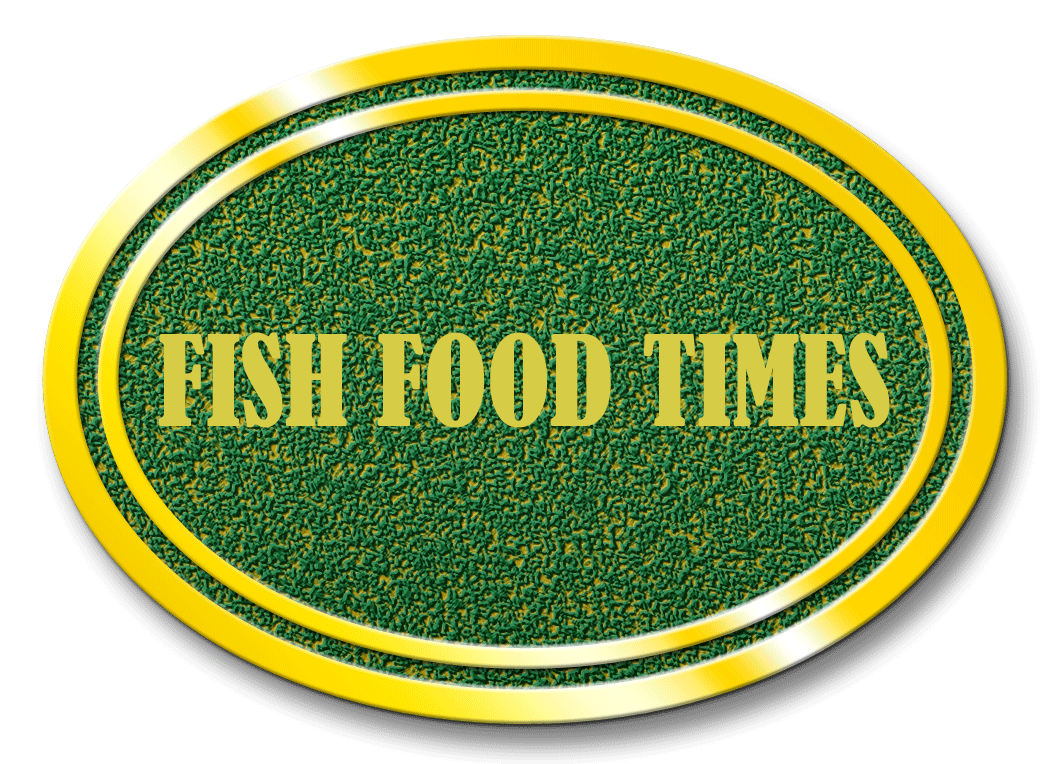
July 2013 issue No.115

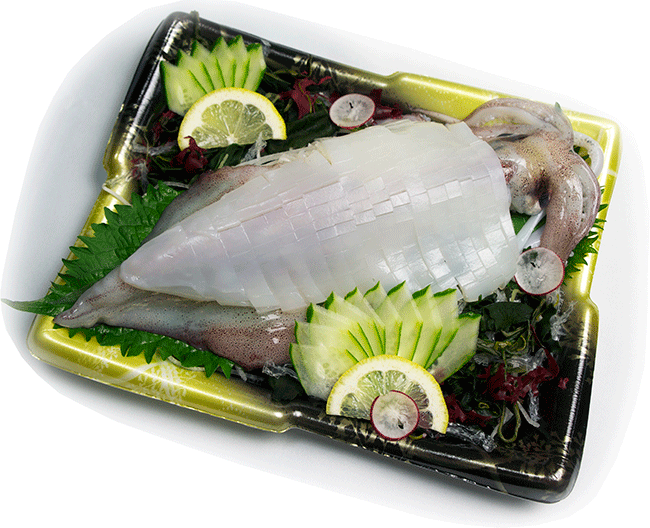
A sashimi of fish-figure for the Yariika
The name this a squid called "Yariika" is a popular name in the districts facing the Sea of Genkai of Fukuoka, Saga, Nagasaki, "KenSakiika" is right formally.
However, this magazine uses "Yariika" which is a name in Hakata because I send it from Hakata.
When it is zoological in these a squid and does an official classification,
order;Teuthida suborder;Myopsida family;Loliginidae subfamily;Loligininae genus; Photololigo swordtip squid
The Yariika has habitation in Honshu central part and to the south and is a raw material called "Kensakisurume" or " Ichibansurume", and When it becomes the dried thing, it becomes the high-quality article unlike a popular "Surumeika".
The body of the Yari ika has sweet taste softly, and even if it boils this, and it bakes it, it is the characteristic of the Yariika that the sweetness stays.
We call "Shiroika" in the San-in district and call it "Akaika” in Kanto and call it "Mizuika" in Hiroshima.
Names are different in this way in the whole country, and the name in northern Kyushu is "Yariika".
The lower image is in condition not to have yet passed very much at time after iIt was unloaded in a fish market, though the translucency of the body is lost and is blushing, the ear still remains a state of the transparence.
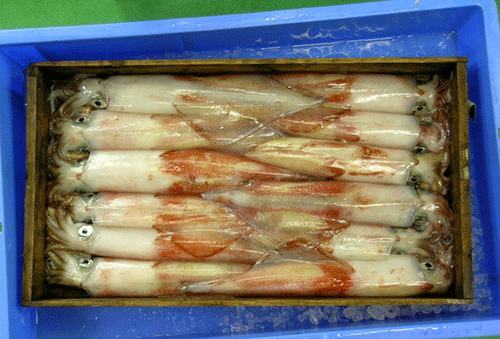
The Yariika are almost received over the autumn after early summer.
The Yariika was unloaded; when is just after it, the body is whitish; is translucent, and the color of the body turns red soon, Then red is blown off this time and changes into darkish white when I take a pause.
As such, as for the Yariika, it is used the name that red or white are various in the whole country by the reason why the physical color of the changes variously and is confusing, when a Yariika in particular is small, the distinction is difficult with closely related KenSakiika, Budoika, Jindoika at the time of small size in particular.
This image is an official name Yariika called Kensakiika in Kyushu.

order;Teuthida suborder;Cephalopoda family;Loliginidae subfamily;Loligininae genus;Loligo Lamarck Loligo bleekeri Spear Squid
In Kyushu (Fukuoka), this is called "Kensakiika" and is landed in the days of late spring from autumn.
It is from Kanto and to the north, and the Surumeika called the another name "summer cuttlefish", but a Susumeika is "a winter cuttlefish" adversely in Kyushu, And a Yariika is "a summer cuttlefish" in Kyushu, and this Kensakiika is "a winter cuttlefish".
The time from autumn to the winter is in season that it becomes about time when spring as for the Kensakiika and lays eggs, and the time is the time to be received a lot of the Kensakiika.
December passes, and the Kensakiika becomes "a mother" when then it is spring, and when the Kensakiika born in spring is autumn, it is with "a small Kensakiika" and "a new cuttlefish" and comes to line up in the fish market.
Though I wrote that it is various about a Yariika and Kensakiika to here, in the district with Japan, we name the name of the Yariika by the name of the Kensakiika and name the name of the Kensakiika it by the name of the Yariika in the district different again.
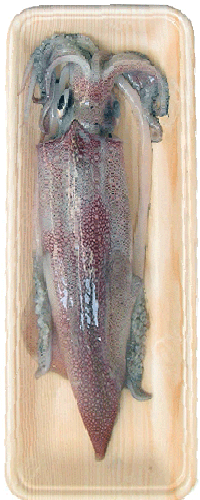

| Left Kensakiika (standard Japanese name yariika) | Right Yariika (standard Japanese name Kensakiika) |
The Kensakiika is unloaded around Miura Peninsula offing and to the west, area west than Wakasa-wan Bay, particularly Kyushu west coast, Goto.
Form of the ear is a lengthwise rhombus, and, with the size like 70% of physical length, as for the length, 35 centimeters, the weight grow up to 600 grams.
As for the Yariika of the upper right image, two arms called the most moving passage arm are thin and are small and are inconspicuous, but can distinguish both kinds in this difference because the Kensakiika of the left image has a long two most moving passage arms in one and is big.
Originally probably an authoritative person called it without permission in Japanese each place, and it named it to distinguish these two kinds of cuttlefishs definitely because it was not generally easy, and it would just go if I needed it.
Because it is permitted that we use the local name about the name of the fish in each place of the whole country, you should just use the district name in the district and it is dignified and should express it by a district name than you are particular about such a name too much.
For example, "A sashimi of fish-figure for the Yariika" of the first page is the local special dish in Yobuko, Saga.
This is not "A sashimi of fish-figure for the Kensakiika" of the standard Japanese name, and a local name "A sashimi of fish-figure for the Yariika" is right.
Therefore I express even the first page of this magazine with ""A sashimi of fish-figure for the Yariika" that is the local name of Hakata.
Then let's introduce a method made with "A sashimi of fish-figure for the Kensakiika".
| Work process made with "A sashimi of fish-figure for the Yariika" | |
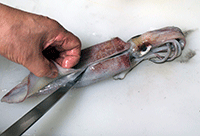 |
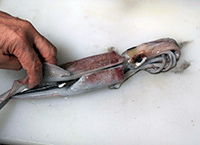 |
| 1With a ship as the top, I install a kitchen knife in the just beside of the ship from the direction of the foot. | 2 Along the just beside of the ship, I put a kitchen knife as if get under to the bottom of the ear. |
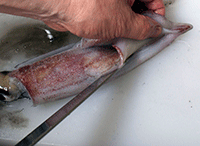 |
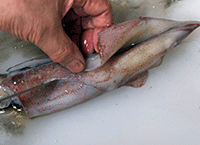 |
| 3 I put a foot towards this side and install a kitchen knife in the just beside of the ship from under an ear. | 4 I let a kitchen knife comply with the just beside of the ship and I go towards a foot and move it. |
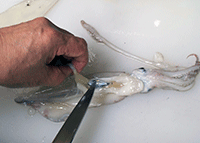 |
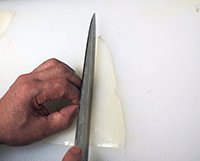 |
| 5 Because a foot, a ship, an ear, the internal organs are left in one form, I remove cuttlefish sumis from there. | 6 After having barked the body, I cut with a decoration kitchen knife to become fiber and the angle of the right angle. |
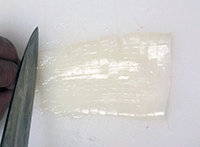 |
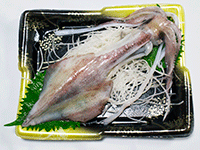 |
| 7 I pull a kitchen knife so that it becomes the angle of the right angle with the direction of the cut end where I made a decoration kitchen knife and cut it. | 8 I put the thing that a foot, a ship, an ear, the internal organs were united on Japanese radish sword |
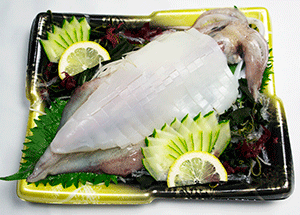 |
|
It does not have a meaning only that the method to be made with the figure of the cuttlefish makes a figure look good simply, after having eaten a cuttlefish as sashimi, with geso and an ear served with the figure structure, there is not waste in a grilling fish with salt and the one which deep-fries it, and can eat.
However, it is troublesome to make a figure structure, and there may be the way of thinking that there is not it in a time to spare to make it.
I think that I understand it if I have you watch an upper process image, but how about the following methods when, in fact, there is not the need made with a figure that is not a so troublesome thing.
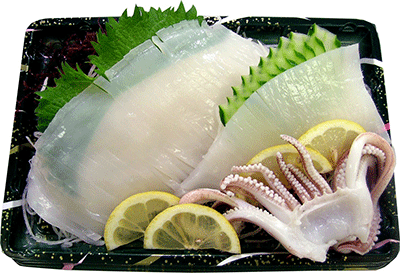
In this case at first I divide geso into half, and do this for half boiling lightly next; then and attach it as "Ashirai" of the sashimi.
Handling of geso has various thought and thinks that I plan not to attach it to sashimi for one thought, and to sell distinction, and to do it, but uses it as a method to raise value in the case of this sashimi.
For example, the lower image is a method of selling according to one of geso,

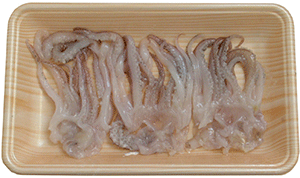
The left image removes "a crow complaint" from geso and the right image does geso in difference and it is easy to eat.
Furthermore, the handling of the ear which comes out by all means if I cook the cuttlefish will be how.
These often may be usually disposed of with the price of next to nothing.
For example, there are the following methods, too.
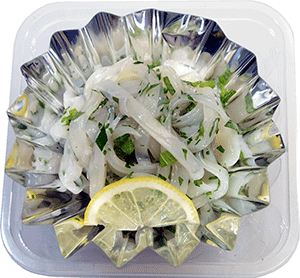
This is sashimi made with the thread using the ear of the Yariika.
This is the texture that is slightly more firm than a body part and it is crunchy and I add chopping fine of the green shiso and start a flavor though it is delicious because with that alone I am unsatisfactory.
And I think that it is a boiled fish dish to be really delicious with this Yariika dish.
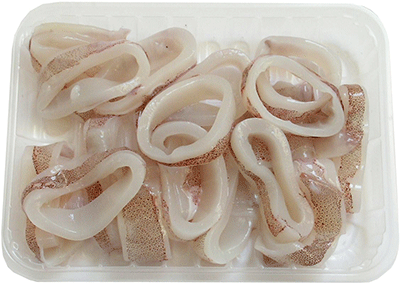
The hard-boiled Yariika has the softness and sweetness of another world with the thing of a Surumeika.
The upper image only did not merely cut a Yariika into round slices and I add a hand a little and make an appearance better.
It is seen in the form that curled up a little than before by semiboiling the Yariika of the slice lightly, and cooling it in iced water.
When completely heat it, become bright red, and there is not a feeling of freshness; therefore is light, and put it through hot water, and must cool it immediately to treat this as eatables.
Finally what cannot exclude this as a method to eat a Yariika deliciously .
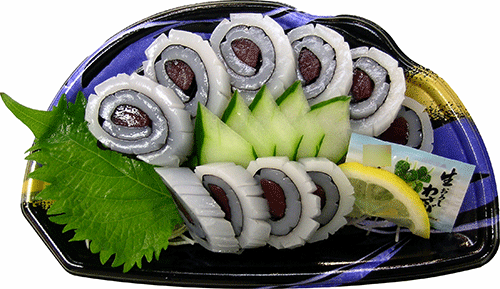
It is this "Naruto tukuri sashimi".
I mention even "December, 2010, No.84 Aoriika Naruto tukuri sashimi"
of FISH FOOD TIIMES about the Naruto tukuri sashimi.
I express "Naruto tukuri sashimi" in No.84 as follows.
I can feel a splendid taste as I feel sweetness. I stick laver on the surface of Aoriika and bind a tuna with this inside, and it is the "Naruto tukuri sashimi" that make like a roll. A flavor of the laver increases more when I do it this way, and the taste of the tuna is mixed and right becomes "the splendid taste that was separated from it". |
In the case of the Yariika, this expression is just usable.
As for the Yariika and the Aoriika, most of Kensakiika are virtually brother, and these cuttlefishs are almost common at at a point having taste of the "taste such as the sweetness".
It is thought that it must be it in cuttlefishs to be the top name deliciously in a point of the taste even if I bake it even if I boil these three kinds of cuttlefishs not to mention with sashimi.
"Yariika" of the one in three kinds of cuttlefishs greets season now.
In now when unloading increases, and the speculation calms down, you should sell it very much.

Date of updating |
July 1, 2013 |
Food commerce contribution sentence
| Food commerce contribution sentence (foregoing volume) |
An opinion and the communication are to info@fish food times
